Motorola Droid Bionic Review - Dual Core with 4G LTE
by Brian Klug on October 11, 2011 1:55 AM EST- Posted in
- Smartphones
- LTE
- Motorola
- OMAP 4
- Mobile
- motorola droid bionic
Cellular Connectivity - Motorola’s 4G LTE
Like most of Motorola’s lineup, the Bionic uses Qualcomm’s MDM6600 for CDMA2000 1x and EVDO (3G) connectivity. There’s nothing out of the ordinary about that at all, and again MDM6600 is a combination HSPA+ (HSDPA 14.4, HSUPA 5.76) and CDMA2000/EVDO Rev.A baseband and transceiver. In the Bionic, only CDMA2000 1x/EVDO is used, on both 850 MHz and 1900 MHz, but more on that in a moment. I started out by looking at the FCC internal photos which are of marginal quality, and then the iFixit disassembly photos which are much better.
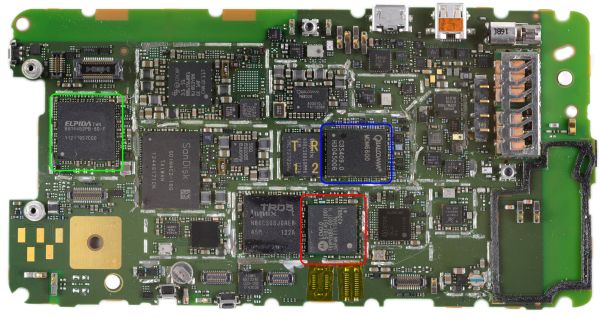
Green square: Elpida LPDDR2 PoP w/OMAP 4430, Blue: Qualcomm MDM6600, Red: Motorola Codename Wrigley LTE baseband
What’s unique about the Bionic is that it uses a Motorola LTE baseband for LTE, instead of MDM9600 which would also be a logical choice. To date, we’ve seen QCT’s MDM9600, LG’s L2000, and Samsung’s CMC220 providing LTE in respective smartphones.
So what about this Motorola LTE modem can we glean? Unfortunately, there’s not a lot out there. The chip is silkscreened with the Motorola logo, and LCM2.0, and it appears like “T6VP0XBG” is another part of the name. Search any of this and you’ll find nothing more than speculation and recursive levels of confusion. Motorola also declined to comment about this particular part.
Adjacent to the Motorola LTE baseband is a Hynix combo 2 Gbit NAND and 1.8V 1 Gbit LPDDR1 DRAM, marked H8KCS0SJ0AER. This is undoubtably for the LTE baseband, as it’s standard fare for each of these to have their own MCP DRAM and NAND. Look above and you’ll see a smaller one (also H8) Hynix adjacent to MDM6600 which we’ve seen over and over.
To the right of the LTE baseband is an undocumented Intel/Infineon transceiver, and then further to the right, a part with Skyworks markings which is almost without a doubt the 700 MHz power amp. Then to the far right you can see two gold pins which mate up with the antenna board that attaches there. You can see where the Tx antennas are for WLAN and CDMA/LTE from the FCC docs. WLAN is off to the side, CDMA/LTE seem to be integrated into one module at the bottom, which is pretty standard.
Above the LTE modem is its CDMA2000 counterpart, again consisting of a Hynix H8 series combo DRAM and NAND, MDM6600, and then to the right an Avago power amplifier marked ACPM–7968. This power amp is actually quad band 850/900/1800/1900 MHz. In its shipping form, the Bionic is limited to just 850/1900 for CDMA2000 in the USA, however, I have very little doubt this device could also be used with WCDMA on all four bands with some tweaking. FCC documents also talk about WCDMA functionality being disabled:
The WCDMA/GSM network functions have been disabled by the firmware and are SIM locked by all US operators on this product.
In addition, inside build.prop are numerous lines and commented out configuration files for both android RILs and other things which are preceded with:
#####Override in cdma_targa.mk until LTE + Global support.#####
I would not be surprised to see a Droid Bionic Global with LTE, EVDO, and WCDMA/UMTS support some time in the future.
I’m unsatisfied with just reporting that some part exists, so I poked around. Delving deeper by poking around inside the Bionic’s /system folder, I uncovered that this baseband actually has a name - it’s Motorola’s codename Wrigley LTE modem, which works like an ethernet over USB (communications device class) device. Interestingly enough, the Droid 3, Bionic, and Motorola Xoom kernels all include the Motorola Wrigley Modem Controller driver. Inside the Bionic are also a few bash scripts that dump wrigley-specific debugging data including some statistics.
The next logical question is what LTE UE category codename Wrigley is. We talked about this in our Verizon 4G LTE piece, but UE category essentially is analogous to the UE category from HSPA - it defines the theoretical maximum throughput in Mbps. The FCC documents are usually a good place to start, however in this case they list UE Category 1, which is completely wrong. You can however tell that it has 2 Rx chains, and 1 Tx chain, just like every other LTE smartphone.
After poking around with the debug scripts on the Bionic, I was able to find what I believe are SNMP MIBs which relate to Wrigley’s configuration. You can see references to object identifiers (OIDs) just like you’d expect for an SNMP configuration, and further, given that Wrigley is apparently an ethernet over USB device, this configuration route makes sense. There are 14 configuration files, some of which include some logging and debug, and only one that mentions LTE.
The two lines I find particularly interesting (outside the whole thing, which is very interesting) are
<mib_value moid="0x818B" value="2"/> <!-- UE Category is by default 2 -->
which is almost self explanatory, and this next one:
<mib_value moid="0x825F" value="5230"/> <!-- Requested EARFCN -->
So there we have it, Wrigley is very likely UE Category 2 for LTE. The fact that it is configured to work on EARFCN 5230 is telling, as this corresponds to LTE Band 13 precisely, which is exactly what Verizon uses for LTE. As a reminder, all the LTE devices we’ve seen so far are UE category 3, which corresponds to a maximum theoretical throughput of around 73 Mbps on the downlink.
Before we leave Wrigley entirely, I should conclude my mention of the Motorola Xoom. For those interested, I did some poking around and found that the Xoom’s LTE module is based on this same exact baseband. It’s immediately visible on the FCC’s internal photos, and as I already mentioned has drivers and references in the Xoom’s kernel.
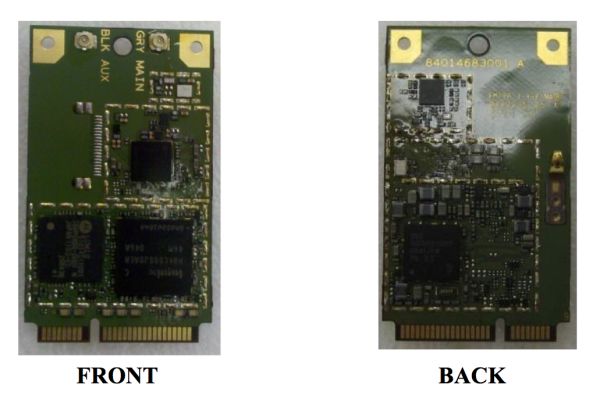
The same Motorola baseband in the Xoom - FCC Internal Photos
That brings me to throughput, which we’ve measured on the Bionic just like every other smartphone since I’ve started doing this. I run a ton of speedtests, gather some data, and create histograms showing the distribution for throughput (downstream and upstream) as well as latency. I did this just on 4G LTE on the Bionic since EVDO is well understood and not really worth exploring much anymore. For the Bionic, I ran a total of 938 tests in my own market in Tucson, AZ, in Phoenix, AZ, and some in Anaheim, CA, and generated those plots. A few people have also asked me to make empirical cumulative distribution functions (ECDF) plots of the data as well, so I went ahead and made those in addition to the normal histograms.
First up is downstream, where the average is 15.9 Mbps, with a maximum of 39.1 Mbps. I’ve tried hard to get close to 50 Mbps but couldn’t hit it.

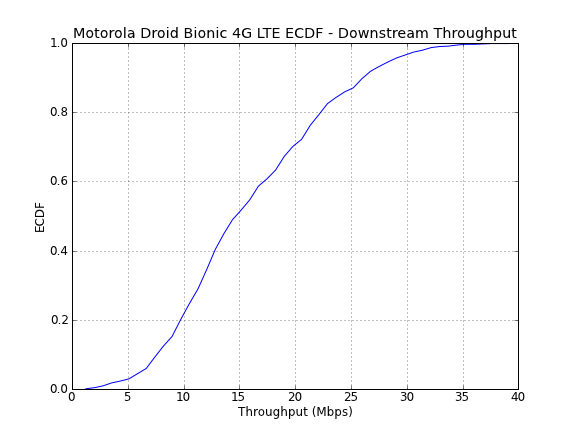
Next is upstream, where I saw an average of 5.7 Mbps up, and a maximum of 18.1 Mbps.
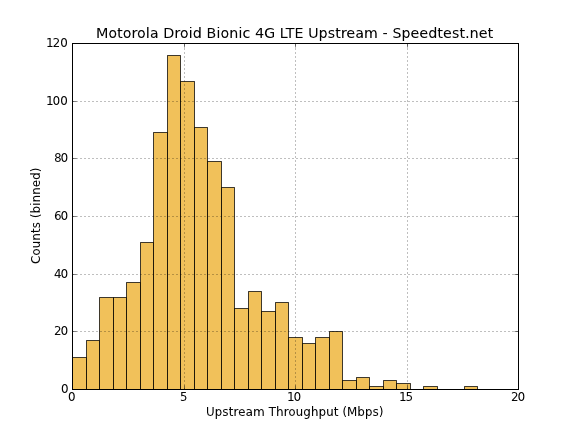
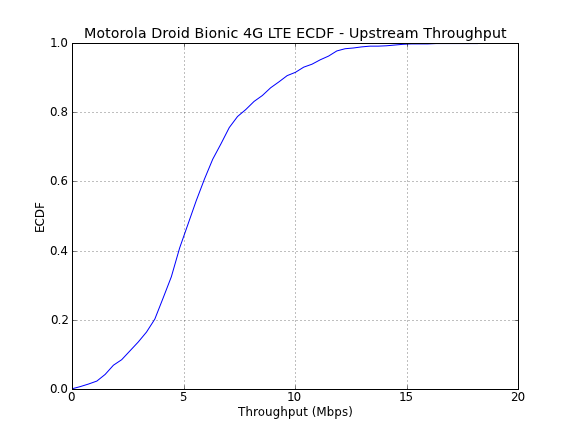
Latency is pretty low on the Bionic, minus a few strange outliers, with an average of 77ms, and a minimum of 36ms.

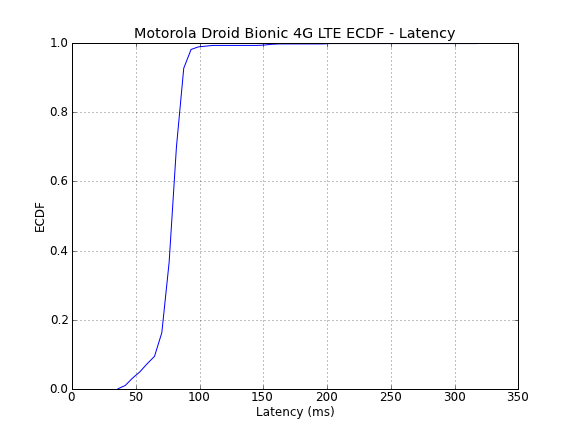
For supposedly being UE Category 2, the Bionic posts speedy results that seem completely in line with what I’ve seen on other UE Category 3 4G LTE devices. I’m not sure whether I just haven’t been able to test the Bionic in a situation where it could go faster but was otherwise limited, but I wager most people won’t be able to tell the difference.
I’d like to reiterate that LTE simply needs to be experienced to be fully appreciated. Were I blindfolded (and in a good signal area) I would have a very tough time differentiating between LTE and a decent wired connection. I played a few rounds of the BF3 beta (for science, of course) over the Bionic while tethered over USB, and found latency almost indistinguishable from my cable connection. It’s a dramatic difference from EVDO in both latency and throughput, one that’s shocking if you get pushed back to EVDO.
The Bionic also is the first device (to the best of my knowledge) that reports 4G LTE signal bars based on channel quality in addition to just received signal strength. Devices like the Droid Charge and others can be somewhat misleading and just report the bar visualization based on signal strength. It took me a while to figure out how to actually get to the Bionic’s 4G LTE signal metrics, as it isn’t the number shown in “About” - that’s actually just what’s reported from MDM6600 for EVDO or 1x.
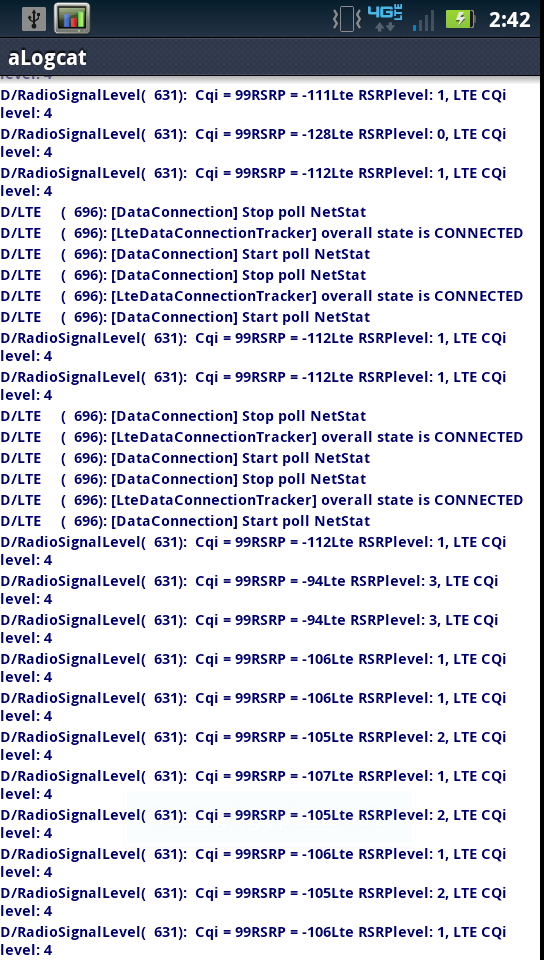

Left: Real LTE signal information shown in logs, Right: MDM6600 signal shown in "About" (same place)
If you run logcat, you can see actual signal information being reported which in turn is used to paint the appropriate number of bars up at the top using RadioSignalLevel(). In the case of the Bionic, the two figures of merit used are the RSRP Reference Signal Receive Power, and CQI Channel Quality Indicator. The phone reports a number from 0–4 for both in addition to just the raw number, and the minimum of these two is the number of “bars” shown, eg min(RSRP,CQI). The result is that this is a much more realistic and practical visualization than most others I’ve seen, and you can also just run alogcat from the Android market, filter by LTE, and see this information in real time.
Finally, I didn’t experience very many stalled data sessions on LTE or other connectivity problems. This of course varies on a market to market basis depending on your coverage characteristics, but in contiguous coverage settings I saw no problems with the Bionic stalling outside the normal one or two seconds to handover between cells. In addition, the Bionic seems to cling onto LTE even down to –115 dBm before falling back to EVDO, which minimizes the number of slow or frustrating handovers. Again, for LTE the real figure of merit is SINR (Signal to Interference + Noise Ratio) which is reported in a bit of an ambiguous manner on the Bionic using CQI.
I’ve also read some confusing reports about LTE data pausing for long periods and suspect this is just confusion which arises from the default battery mode setting - nighttime saver - which stops account synchronization between 10 PM and 5 AM. Motorola sets this by default on all its devices, and I don’t think most people realize it. I always end up setting this to maximum performance and use a charger next to my nightstand.


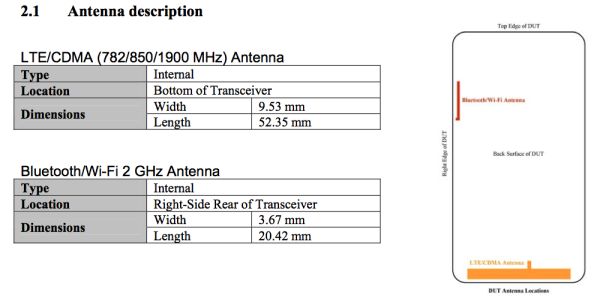
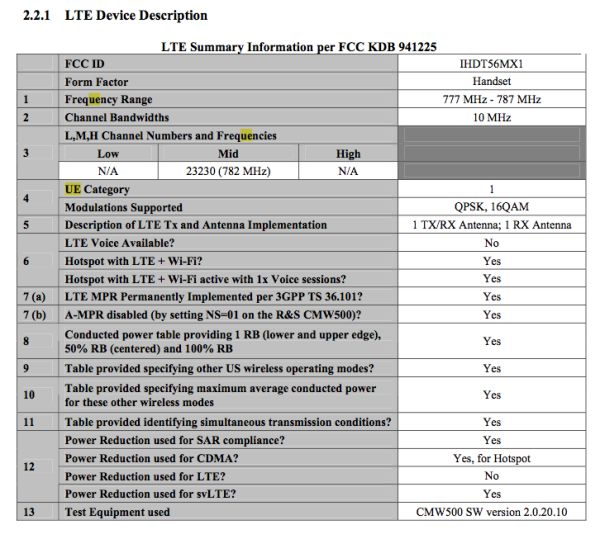
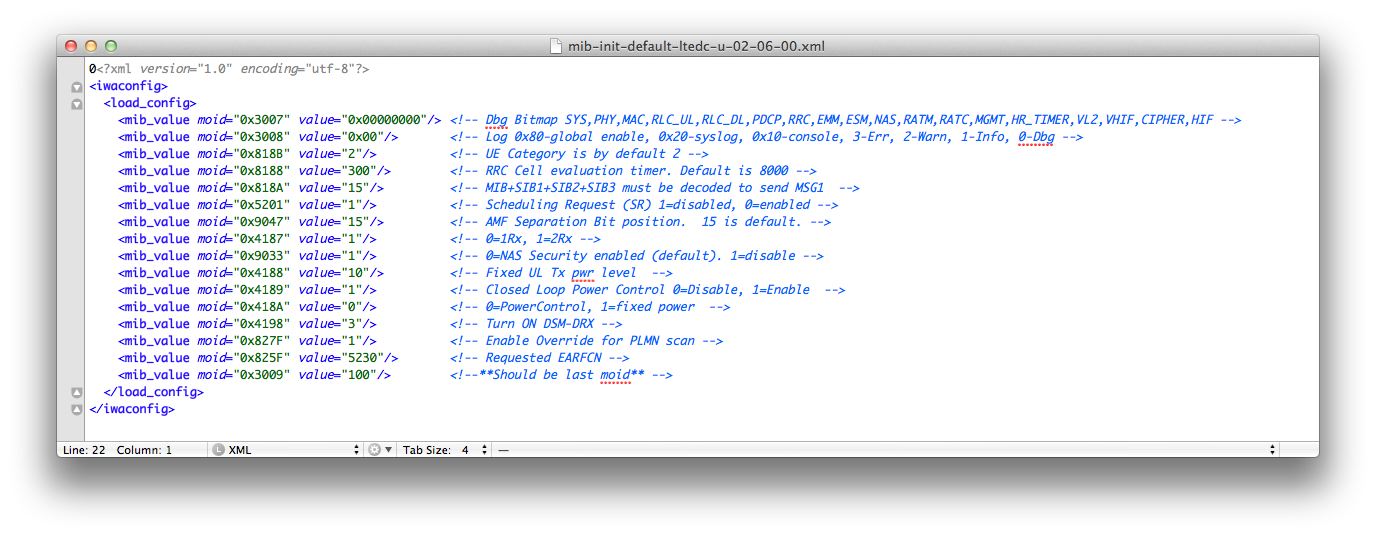
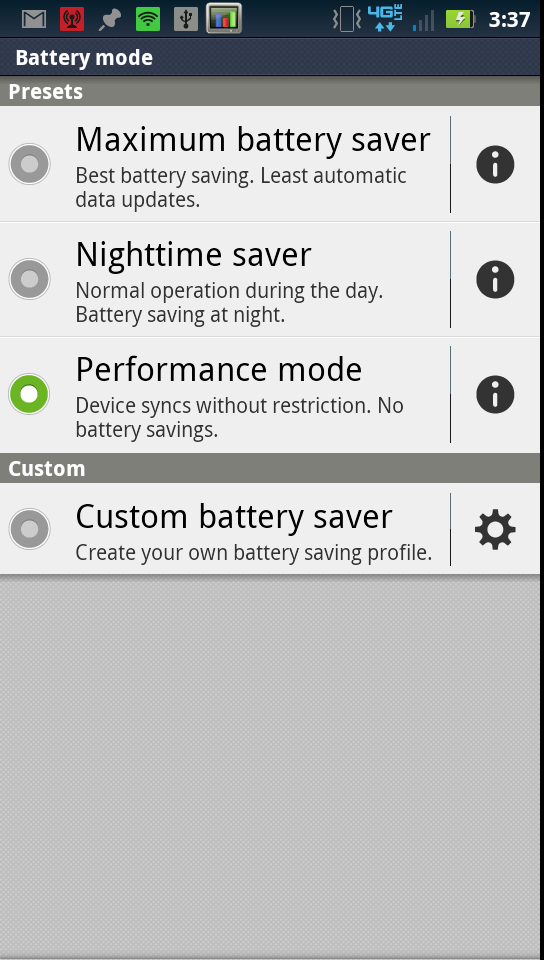
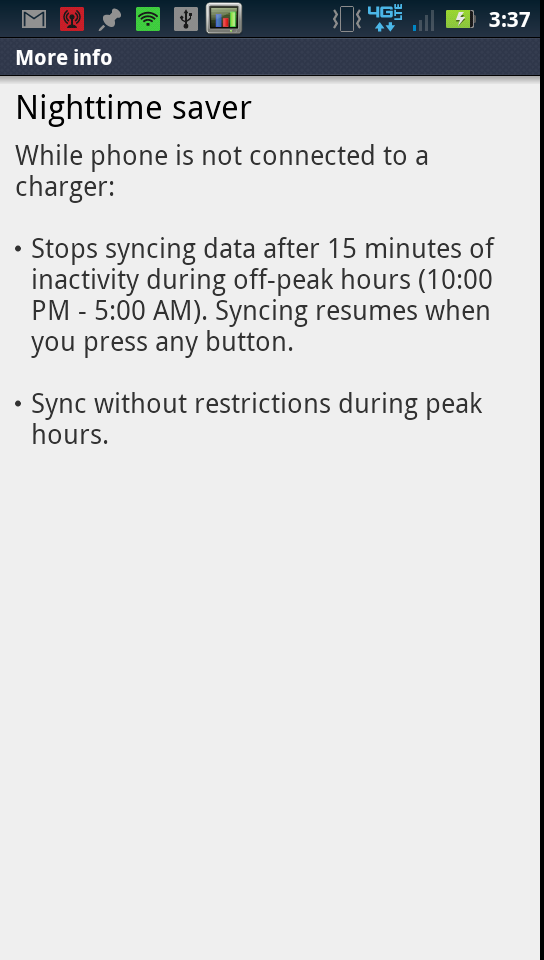








64 Comments
View All Comments
Jamezrp - Tuesday, October 11, 2011 - link
Hmm, that's not good. I'll have to get in touch with Verizon about that. Switching to airplane mode doesn't fix it, only rebooting or going in and out of sleep mode does.I have read some reviews that have claimed similar issues though. I'll keep my eyes open and report back in.
secretmanofagent - Tuesday, October 11, 2011 - link
I'd get it replaced, I'm seeing the same issues and I'm having mine replaced.toomany - Friday, October 14, 2011 - link
I had this phone for 3 weeks and ended up returning it. It was great for about a week and half then the problems began.Let me start by acknowledging that I may have had a lemon.
The very first trouble I had was when the phone did not get any data connection or send texts without any indication one day. The status bar up top showed the 4G icon so it took me until the afternoon to realize this. A reboot fixed this issue. Since then, on at least 2-3 occasions, the touch-screen would not respond or not turn on. I've had to pull the battery out twice. Then let me talk about the back button which annoyed me on several occasions, it just takes you back to whatever was on the screen before. For example, if I'm on the browser, then switch over to maps for a sec to find directions or a store, then switch back over to the browser, hitting the back button should go to the previous page. No, it'll take you back to your map (and there is no back on the orig browser). You'll eventually run into situations where this causes you to restart an app and lose progress.
Lemon or not, I'm not taking any chances when I can be stuck with it for the next 2 years. Also, DON'T BUY VERIZON AT RADIOSHACK!!! THEY GET HORRIBLE TRAINING, TAKES FOREVER, SCREWS YOU, THEN TRIES TO TELL YOU IT'S YOUR FAULT.
corymcnutt - Saturday, October 15, 2011 - link
"Other quirks include the awful shortcut-adding method, no settings in the drop-down menu, and a few more which escape me because it's late. On my model it even reads only 8GB of onboard memory, plus the 16GB card. The more I investigate, the more I think my model may be slightly defective...""Awful shortcut adding method?" This is my first Android (coming from BB) and I think it is easy to get shortcuts/apps/widgets to where you want them. Your memory is correct...that has been discussed at length...the on-board memory still gives you PLENTY of room for apps and the 16GB card will store all of you pictures, music etc..
sandtrap94 - Saturday, October 15, 2011 - link
I've had the exact same issues with my phone. I lose the data connection on occasion and only restarting the phone seems to work. Per the company it is not unheard of but it shouldn't happen frequently. If it does they want to know about it.lemmo - Tuesday, October 11, 2011 - link
Thanks for the review. You say you're still working with Francois to build out your audio testing suite. Will you be doing a review that compares the audio quality between smartphones? I can't find this info anywhere.It's a shame that audio quality is a let-down for this phone, and the Galaxy S2. I'm waiting for the reviews of the new iPhone and Nexus Prime just to see if their audio quality is better...
Brian Klug - Tuesday, October 11, 2011 - link
Yeah we're absolutely still working on a standardized testing methodology for sound - the thing to standardize here is the audio card (which we both have the same of - ASUS), a Y cable plus load headsets (testing unloaded isn't really meaningful), and the software.Unfortunately the Bionic is already so bad that really tests would just tell you all of that again. Listening to the Bionic and then to my Nexus S with voodoo sound - the difference is shocking.
-Brian
Sea Shadow - Tuesday, October 11, 2011 - link
It's late and I'm about to retire for the evening, but I thought I would take the time to log in and say thank you for a thorough review.For me Anandtech is one of the last bastions of lengthy reviews as more and more sites slip into lots of pictures and glossing over the gritty details. I enjoyed the review and especially so the details about battery chemistry and the RGBW displays.
Only thing you may want to double check is the listed order of the phones on display at CES. I understand one is left to right and the other is right to left, but the paragraph in the article seems to have the LG revolution and Samsung Charge flipped. Other than that, spot on job and thank you for a great read.
Brian Klug - Tuesday, October 11, 2011 - link
OOps, very good catch! Should be fixed momentarily! Thanks!-Brian
MGSsancho - Tuesday, October 11, 2011 - link
Does it have a locked bootloader like the Droid 2? If so it is a deal breaker for me. Other than that, all I personally look for in a review is the screen (all attributes,) Picture quality, time it takes from button depress to ability to actually take a picture, and battery life. Keep up the good reviews